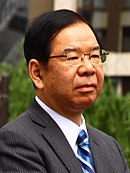
Back الانتخابات العامة اليابانية 2017 Arabic Eleccions generals japoneses de 2017 Catalan Shūgiin-Wahl 2017 German Γενικές εκλογές στην Ιαπωνία (2017) Greek Elecciones generales de Japón de 2017 Spanish Japanin parlamenttivaalit 2017 Finnish Élections législatives japonaises de 2017 French जापानी आम चुनाव, 2017 Hindi Pemilihan umum Jepang 2017 ID Elezioni parlamentari in Giappone del 2017 Italian
| |||||||||||||||||||||||||||||||||||||||||||||||||||||||||||||||||||||||||||||||||||||||||||||||||||||||||||||||||||||||
All 465 seats in the House of Representatives 233 seats needed for a majority | |||||||||||||||||||||||||||||||||||||||||||||||||||||||||||||||||||||||||||||||||||||||||||||||||||||||||||||||||||||||
|---|---|---|---|---|---|---|---|---|---|---|---|---|---|---|---|---|---|---|---|---|---|---|---|---|---|---|---|---|---|---|---|---|---|---|---|---|---|---|---|---|---|---|---|---|---|---|---|---|---|---|---|---|---|---|---|---|---|---|---|---|---|---|---|---|---|---|---|---|---|---|---|---|---|---|---|---|---|---|---|---|---|---|---|---|---|---|---|---|---|---|---|---|---|---|---|---|---|---|---|---|---|---|---|---|---|---|---|---|---|---|---|---|---|---|---|---|---|---|---|
| Turnout | 53.68% ( | ||||||||||||||||||||||||||||||||||||||||||||||||||||||||||||||||||||||||||||||||||||||||||||||||||||||||||||||||||||||
| |||||||||||||||||||||||||||||||||||||||||||||||||||||||||||||||||||||||||||||||||||||||||||||||||||||||||||||||||||||||
| |||||||||||||||||||||||||||||||||||||||||||||||||||||||||||||||||||||||||||||||||||||||||||||||||||||||||||||||||||||||
General elections were held in Japan on 22 October 2017.[1] Voting took place in all Representatives constituencies of Japan – 289 single-member districts and eleven proportional blocks – in order to appoint all 465 members (down from 475) of the House of Representatives, the lower house of the then 707-member bicameral National Diet of Japan. Incumbent Prime Minister Shinzō Abe's governing coalition of the Liberal Democratic Party (LDP) and the Komeito party retained their seats in signs of what was perceived as weak opposition. The PM won his fourth term in office and held on to the two-thirds supermajority in order to implement policies on revising the war-renouncing Article 9 of the Japanese Constitution.[2]
The snap elections were called in the midst of the North Korea missile threat and with the largest opposition party, the Democratic Party, in disarray. Just hours before Abe's announcement of the snap election on 25 September, Governor of Tokyo Yuriko Koike launched a new conservative reformist party Kibō no Tō, the Party of Hope, which was seen as a viable alternative to the ruling coalition. It soon led to the dissolution of the Democratic Party and its party members defecting to the Kibō no Tō.[3] However, the liberal wing of the Democratic Party, whose members Koike refused to nominate, formed the Constitutional Democratic Party of Japan (CDP) led by Yukio Edano, splitting the opposition in half.[4] The elections turned into a three-way contest as the CDP joined with the Japanese Communist Party and Social Democratic Party on a common platform opposing the constitutional revision. While Kibō no Tō fell short of expectation, the CDP surged in the polls in the last days before the elections and beat Kibō no Tō to emerge as the largest opposition party.[5]
Despite being disrupted by Typhoon Lan, the elections saw a slight increase in turnout rate of 53.68 percent but still was the second lowest in postwar Japan. The lowest ever turnout was recorded in 2014.[6] They were also the first elections after the voting age was lowered from 20 to 18.[7] Abe also became the first Prime Minister to win three consecutive general elections since 1953 and the first LDP leader to do so. He became the longest-serving Prime Minister in the history of the country in August 2020, but resigned shortly after achieving this due to health issues.[8]
- ^ Pekkanen, Robert J.; Reed, Steven R.; Scheiner, Ethan; Smith, Daniel M. (2018). Japan Decides 2017. doi:10.1007/978-3-319-76475-7.
- ^ "Shinzo Abe gains big victory in Japan election". Financial Times. 22 October 2017.
- ^ Asano, Masahiko; Patterson, Dennis (2022). "Risk, institutions, and policy in decisions to join a start-up party: evidence from the 2017 snap election in Japan". Japanese Journal of Political Science. 23 (1): 34–54. doi:10.1017/S1468109921000402. hdl:2346/92774. ISSN 1468-1099.
- ^ "How Japanese PM Shinzo Abe won a sweeping electoral triumph". Financial Times. 22 October 2017.
- ^ "立憲民主党、野党第1党が確実(衆院選2017)". Huffington Post. 2017-10-22.
- ^ "Election turnout likely second-lowest in postwar period, estimate says". The Japan Times. 2017-10-23.
- ^ Cite error: The named reference
agewas invoked but never defined (see the help page). - ^ Rich, M. (22 November 2017). "Japan Election Vindicates Shinzo Abe as His Party Wins Big". The New York Times. Retrieved November 27, 2017.








